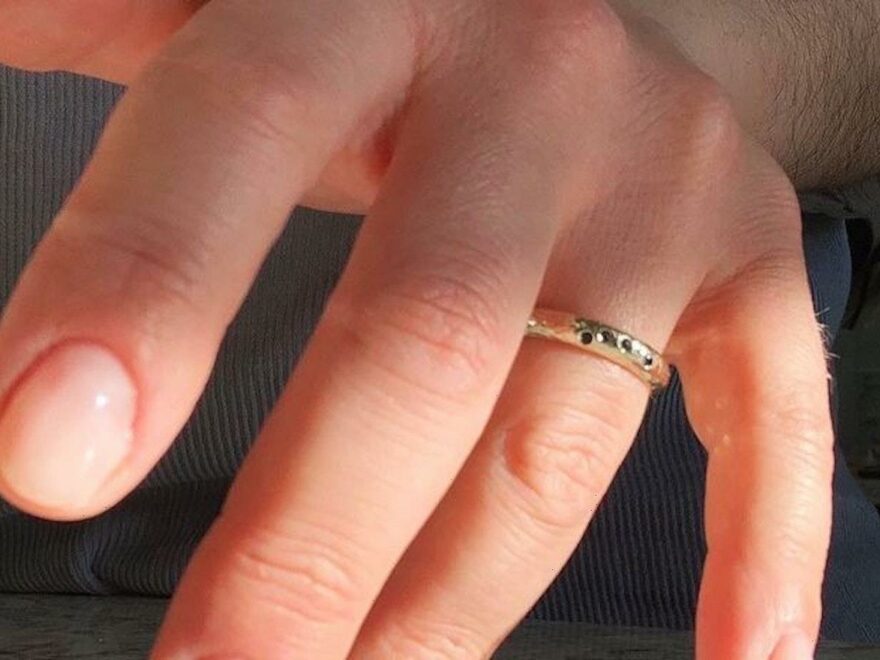Written by Lucy Partington
Freelance beauty editor Lucy Partington is obsessed with all things skincare, collecting eyeshadow palettes that she’ll probably never use, and is constantly on the hunt for the ultimate glowy foundation.
Strong, natural nails is where it’s at – and using builder gel can help give you your best yet, but what exactly is BIAB and how does it work?
Chances are you’ve seen the new wave of minimal manicures doing the rounds on social media. It seems we’ve swapped the bold reds, deep burgundy and summer black shades for something altogether more simplistic and, well, a bit more subtle. It’s no make-up make-up but for your nails.
And while there was a time when the secret to those perfect almond-shaped nails, most often painted in shades of milky white and your-nails-but-better pinks, was either extensions or acrylics (unless, of course, you’re one of the lucky ones blessed with good genes and naturally strong nails), that’s not so much the case any more. Instead, there’s a new trend in town – and it’s one that helps stop you from biting your nails and encourages your natural nails to grow, making them longer and stronger than ever before.
The trend in question? Builder in a bottle – also known as BIAB or builder gel. It’s a professional product that sits somewhere in the middle of regular gel (or Shellac) polish and acrylics, and is becoming more widely available in salons across the country. We spoke to Alex Philamond, luxury manicurist and founder of Put It In Nudetral, and asked him exactly what’s worth knowing before booking in for an appointment. This is what he told us…
What is BIAB?
BIAB – which stands for builder in a bottle – also known as builder gel is a range of strengthening gel products that are applied to the natural nail, much in the same way regular gel polishes are, but it has a thicker consistency that improves the nail’s strength. That added protection enables nails to grow steadily and lessens the chances of snapping or breakage.
What’s the difference between BIAB and gel or shellac?
BIAB is ultimately still a gel product but with a thicker consistency. When it cures under the lamp, it creates a harder and more durable finish than regular gel polish. Generally BIAB comes in a smaller range of colours (mostly pale and pastel shades of pinks and purples), but you can apply any other gel polish over a clear BIAB base if you want to, meaning you can still go all out with nail art and bright neons if you fancy.
What’s the difference between BIAB and acrylics?
The strength that both acrylic and builder gel provide isn’t dissimilar, but the difference is in the application. BIAB requires exposure to UV light in order to cure (meaning it hardens from a gel to a solid), whereas acrylic comes in a powdered form that, when mixed with a liquid monomer (a bonding agent that binds with the powder to become malleable) will cure when left to air dry. Once both have cured, they can be painted or decorated to the client’s choosing.
How does BIAB help strengthen natural nails?
It’s the thickness of BIAB that provides reinforced strength, durability and protection from external factors like knocks and bumps. BIAB can also be used to repair broken nails, and provide short extensions that can then be shaped.
How long does BIAB last?
There are so many variables here, for example: the length of the natural nails underneath, how nails are treated once the manicure is done, whether the recommended aftercare is done properly (which usually includes regularly applying cuticle oil, not submerging hands in warm water for long periods of time and not using nails as tools). However, for the average person, I’d expect most would be able to go around two to three weeks between appointments, when BIAB can either be removed and reapplied, or ‘infilled’ – which is where the existing polish is filed down and the gap between the old BIAB and the natural nail is filled in with a fresh layer.
What’s the best way to remove BIAB?
BIAB can be soaked off just like regular gel polish. Its thicker consistency means it takes slightly longer to remove, but soaking it in acetone softens and breaks down the bonding to allow it to be removed safely and without damaging the natural nail. It goes without saying, but don’t ever pick off gel, BIAB or acrylic because you risk peeling away layers of the natural nail, causing thin, brittle and sensitive nails that have to be grown out.
Is BIAB dangerous and can it damage natural nails?
This is a bone of contention within the manicurist community at the moment, as certain brands of builder gel contain adhesives called acrylates, which clients can develop allergic reactions to. These allergic reactions can present themselves differently from person to person, but some of the most commonly seen are either contact dermatitis (itching, burning or scaling of the skin in the affected area) or onycholysis (the nail plate detaching from the nail bed). Precautions that can be taken are being certain that the BIAB is fully cured for the allocated time, according to the manufacturer’s guidance, and ensuring it doesn’t make prolonged contact with the skin around the nail. Brands are adapting to the rise of allergic reactions, however, and new builder gels that are free from specific acrylates linked with these allergies are being introduced to the market.
Main image: Alex Philamond / Put It In Nudetral
Source: Read Full Article
